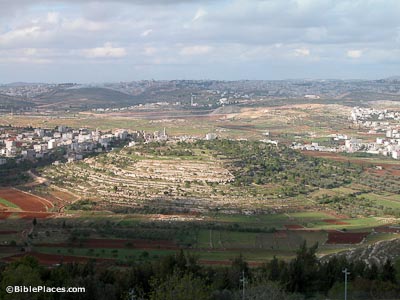 |
| the supposed site of ancient Gibeon, courtesy, BiblePlaces.com |
After the
destruction of Jericho and Ai, the people of Gibeon sent ambassadors to trick
Joshua and the Israelites into making a treaty with them. The Gibeonites
presented themselves as ambassadors from a distant, powerful land. Without
consulting the high priests, Israel entered into a mutual pact with them but Joshua
then realized he had been deceived. In response, he cursed and enslaved them as
woodcutters and water-carriers (Joshua 9:3-27). That it was not wholly in the
possession of the Israelites, even during the time of King David and after, is
shown by II Sam. Ch. 21. After the end of the Babylonian Captivity and the
return of the Jews, Gibeon came within the borders of Judea. Josephus described
the site as forty furlongs distant from Jerusalem, but in the course of the
Roman occupation, Gibeon lay abandoned.
 |
| the Israeli village of Giv'on Hadasha, courtesy Wikipedia |
In 1895,
Jews began to return to the area, led by Yemenite Jews, and they established the
village Giv’on HeHadasha nearby the ancient city’s ruins. They, later, left the
area but it was again resettled in 1924. This new community was expelled by
Arabs as a result of the Arab riots of 1929. It was resettled for a final time
in 1977 by members of the organization Gush Emunim. It eventually absorbed many
Jewish emigrants from the former Soviet Union, as well as many Sabras.
Today,
Giv’on Hadasha continues to grow and develop, and presently includes the
neighborhoods of Nahlat Banim, Dromit,
Hazayit, Giv’on Mizrah, and Ginv’on
Maarav. The town contains three gardens – Rosh HaGiv’a, Zima, and Pini
– the synagogues Chayei Adam and Yisa Bracha, the Alon Community Club, a toy
store, and a tool store.
No comments:
Post a Comment